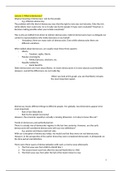Samenvatting
Inclusive summary for the democratisation exam.
- Instelling
- Radboud Universiteit Nijmegen (RU)
This is a full summary of all the lectures of the democratisation course. It does not include any of the readings, but it does include what is told about the readings in the lectures with the name of the author so you can look up the corresponding readings.
[Meer zien]




